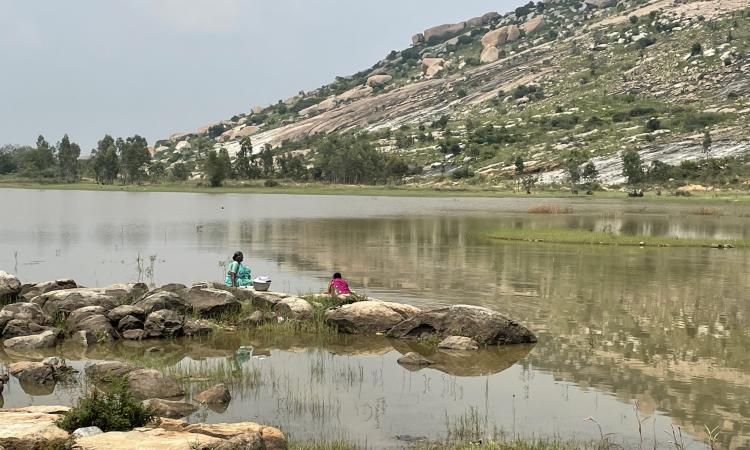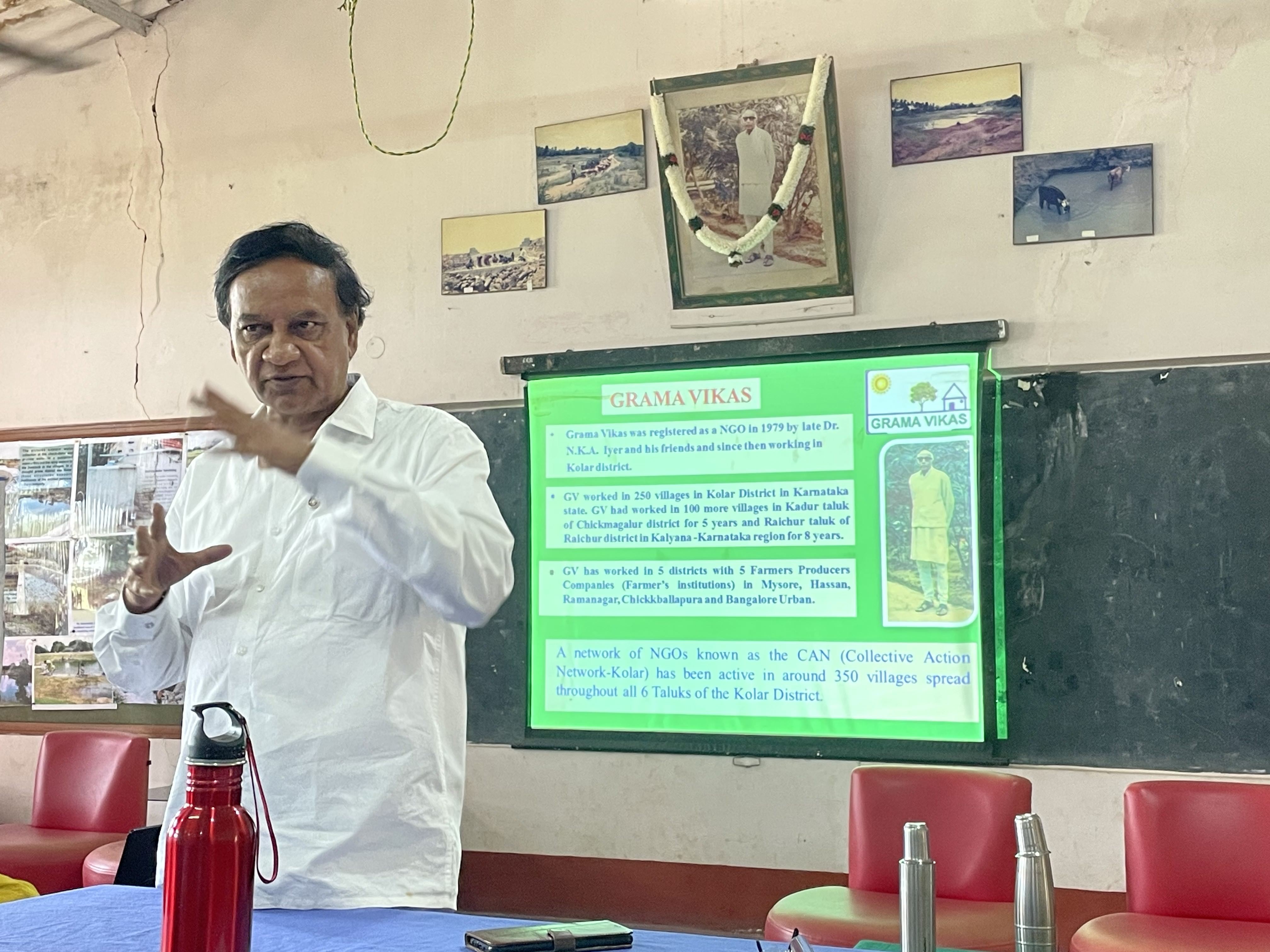
Field visits are an exciting enterprise, especially as a young student who wishes to understand rural India. But they are also a complicated process of seeing and discerning, trying to figure out what is real and what is not. Hagiographies of local mobilisation are common in such endeavours, which, in some cases, are justified. To give into such tendencies is to pick the easy way out. The alternative might be to probe the real and discern the unknown.
On a Wednesday morning, we visited the Grama Vikas office at Mulbagal Taluk, Kolar district. The Executive Director of Grama Vikas, Dr. M. V. N. Rao welcomes us to the area. Rao is a cheery fellow who is used to having visitors. We arrive as a cohort of students and researchers from Bengaluru, here to explore the work his organisation has been doing in Kolar for decades.
As you arrive in Kolar, it gives the impression of huge boulders lined with no vegetation in sight. But the Grama Vikas office is situated around trees. Founded by Dr. N. K. A. Iyer in 1979, a Kolar native, the organisation has been committed to ensuring the social and economic development of the region, with an emphasis on the natural resource management of neighbouring villages.
Rao sets up the premise of the story. It is 1965, and Kolar has faced a terrible drought this year with only 12 inches of rain. The obvious alternative is to use groundwater. Instead of reviving the water tanks Kolar is known for, the impulse was to use groundwater.
Rao notes that the groundwater level was 25 feet in 1965. At the time of writing, borewells had reached 1500 feet and, in some cases, even 2000 feet. The depletion is expected since groundwater has become a major source of irrigation in Kolar, and recharging is difficult since the district has no perennial rivers. It has three small rivers, but they are rainfed.

Rao goes on to explain the tank system. The catchment area is the region where most of the rainwater will be collected. This is a large region with various feeder canals to drive the water to the tank bed area. The latter is the area where water is stored. From the bed area, the water flows into the command area, where most of the plantation takes place. These two regions are separated by a long tank bund, and the flow is mediated through sluice gates.
While walking across the tank, we are joined by a member of an environmental rights group who tells us about the struggle of keeping the catchment area intact. There have been repeated attempts by various organisations to start mining in the area, which will not only mean a lack of agricultural security for the locals but also heavy damage to the local biodiversity.
Who owns the lake? A question emerges from discussions. This is an exciting question, and Rao harks back to constitutional provisions to answer this question. He promptly replies that it is the Gram Sabha, under the 73rd Constitutional Amendment, that is responsible for handling the village resources, including the tank. Further, a large part of the work that GV does is making people aware of their rights as members of the Gram Sabha.

Another question: Who benefits from the lake? What if my crop fields are not part of the command area? What relevance would the tank have for a landless labourer? At this, Rao pauses, smiles, and acknowledges the question. ‘Water belongs to everyone’ he says, ‘whether you are part of the catchment area or not is of no relevance, then anyone from the village can take the tank’s water’. A hush falls over everyone. Is this true? Are common resources part of such an egalitarian logic in Kolar’s villages? Rao adds, and this time it is easier to believe him, that the tank’s health recharges the groundwater that is used throughout the region by means of wells.

We walk over to the well; the water is at an adequate level. The well is characterised as a sacred place, and we are encouraged to take off our footwear before coming close to the well. The water looks whitish; we are told it contains magnesium and salt and is drinkable. As we stand next to the well, a young woman comes and fills her vessel. Vishwanath Srikantaiah, the water expert who is leading this cohort, comments that it is necessary to have a pulley system; the labour of this process moderates the use of water. If they put a motor here, he adds, all of the water will be gone in an hour. The young woman is also barefoot and squats near the well to clean her vessel’s surface. We realise this may be the real reason why footwear is discouraged in the compound.
She walks back, hurling the vessel to one side of her body, walking as swiftly as she came, unperturbed by the set of strangers who notice her every moment. We watch her up to the point where she disappears in the thick trees of Mulbagal.
Irrigation security for rainfed agriculture is under threat. The Government of India's assessment regarding climate change's impact on production levels indicates that, without adaptation measures, rain-fed rice yields will decrease by 20% by 2050 and 47% by 2080. Kolar's prolonged struggle with groundwater recharge and consistent efforts to protect catchment areas from encroachment can be seen as pivotal strategies for adapting to an increasingly water-scarce future.
The issue of water access remains a pressing concern in rural Karnataka, especially as tensions over the Cauvery water dispute with Tamil Nadu intensify. In a recent press conference, Kurubur Shantakumar, president of the Federation of Karnataka Farmers’ Association, voiced grievances about the insufficient power supply for irrigation and the release of water to Tamil Nadu from the Cauvery basin. It's worth considering the extent to which Karnataka's irrigation and drinking water demands are met by the Cauvery basin. Any serious study of the state’s water struggle must account for this: How much is the KRS dam and its water release emblematic of the state's broader water concerns? The answers might surprise many of us.
But it must be admitted that the way out of the politics of water is through it. This journey commences at the Mulbagal well, where questions of access, equity, and justice come to the fore.
Anshul Rai Sharma is a Bengaluru-based researcher working with Azim Premji University. He can be reached at anshul.sharma@apu.edu.in
/articles/beneath-surface-journey-kolars-water-management